Persian shield - Strobilanthes dyerianus
The Persian shield - Strobilanthes dyerianus is an attractive, slow growing, tender perennial for shady areas.
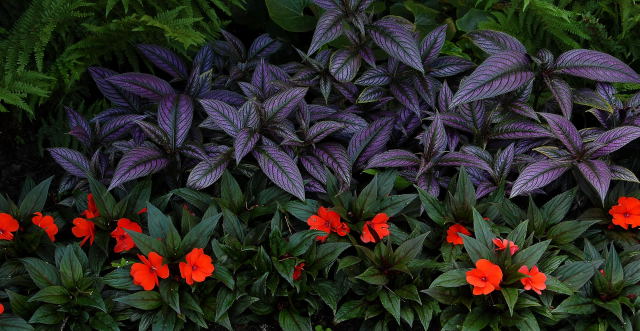
Although this plant can be grown in sunny locations, to bring out the deepest purple in the leaves, shade is preferable. Warm shade is ideal for maximum growth but the Persian shield copes reasonably well in the cool shade of an English summer. People from warmer parts of the world claim to achieve bushes 2-3 feet in height but in cooler climates, plants (taken from cuttings the previous autumn) are more likely to grow 8 to 14 inches (20-35 cms) over the summer . As a result of this it is best to plant densely in order to achieve any sort of impact in the border.
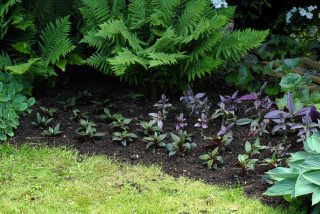
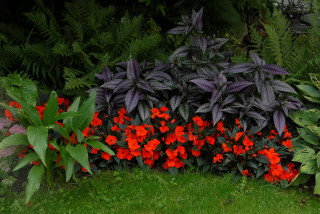
In this example the Strobilanthes dyerianus were planted out on the 1st of June (left hand shot) along with some 'New guinea' impatiens. By the 9th of September (right hand shot) had achieved a reasonable amount of growth. (For anyone keeping tabs, the top picture was on the 5th of August).
Although the Persian shield is not that commonly available (in Britain at least), small plants do turn up (inexpensively) from time to time in the bedding plant sections of regular garden centres. More specialised nurserys offer larger plants but at relatively high prices. The trick therefore is to grab a load when they make an appearance and propagate your own plants thereafter. Fortunately this is easy...
Propagation of Persian shield - Strobilanthes dyerianus
Cuttings can be made in the usual manner (cuttings page) but a far easier method of propagating is by simply placing the cutting in water.
- Take a container such as a plastic cup.
- 3/4 Fill it with water.
- Cover with cling film and make a hole in the middle.
- Prepare a cutting.
- Push your cutting through the hole ensuring the stem reaches into the water.
- Wait about 3 weeks then pot up in soil, keeping the soil quite wet for the first few days.
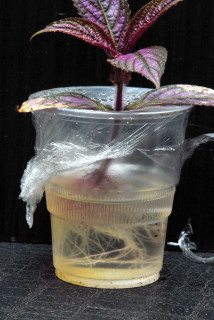
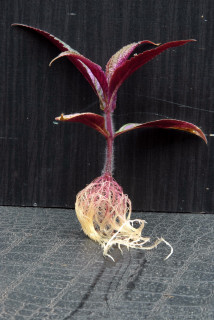
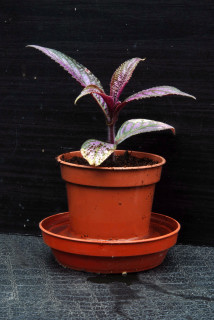
Alternatively a heated propagator can be used for larger quantities and to speed the process up:
- Tie plastic coated wire around the heated propagator base to create a frame.
- Cover the frame with cling film. Overlap the sheets to give a good seal and add strength.
- Make small evenly spaced holes, (the number being dependent on how many cuttings you have taken), and place the propagator in a bright location out of direct sunlight.
- Fill with water and then push the Persian shield cuttings through the holes.
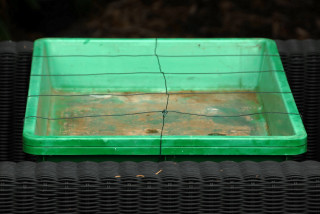
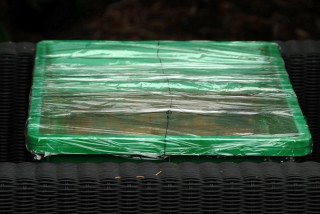
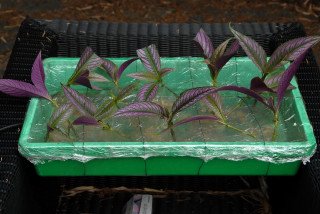
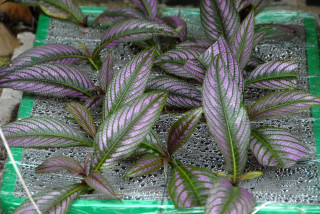
- After 3 weeks the cuttings should have produced roots and have begun to grow. In this instance the water temperature within the propagator base ranged from a minimum of 21°C to a maximum of 34°C.
- Once the Strobilanthes dyerianus have produced roots they can be potted up in multi-purpose compost.
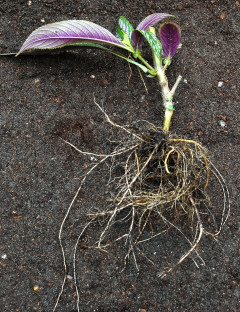
It is said that the roots produced by suspending the cuttings in water have a slightly different make up from those created in a solid medium and need to adapt to a drier environment. Once potted up the stroblianthes cuttings should be replaced into the propagator base (The cling film and frame now removed). Water is poured into the base of the propagator. As the water evaporates over a period of a few days, the roots are able to slowly acclimatise to drier conditions.
If you are short of cutting material, whatever is left of the original plant can also be up-rooted and re potted and placed on heat. The results however are never as satisfactory as when using stem tip cuttings.
It can be seen from this picture that the soil grow roots are much finer than those grown in water
The best time to take cuttings is September/October time but before the the first frosts. It is possible to take cuttings of the cuttings to boost stocks. This is done at the end of February /early March if they have put on sufficient growth. This assumes that you have:
- An idle propagator.
- Sufficient space left to house these extra plants.
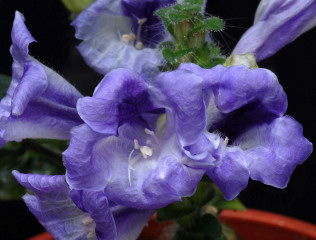
Flowers of the Persian shield - Strobilanthes dyerianus
Although the Persian shield does produce flowers, it is for its foliage that it is grown. Once a stem begins to flower, the size of the leaves on that stem get smaller resulting in a scruffier plant.
The flowering stems can be removed but this does not seem to propel the plant into a foliage producing frenzy.
Left on the plant the flowers eventually produce seed pods but so far the seeds within have failed to germinate.
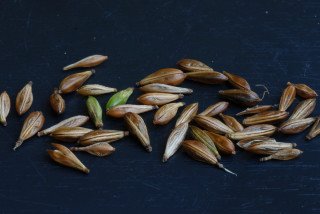
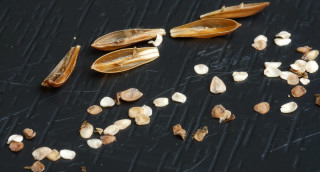
Growing the Persian shield - Strobilanthes dyerianus
As Mentioned earlier, shade and preferably warm shade brings out the best colours of the Persian shield. When grown in a sunnier position the plants do not seem to suffer but the foliage is much more silvery than deep purple which pretty much misses the point of growing this plant.
Strobilanthes dyerianus prefers a moist, friable soil that it can easily get its roots into, i.e. not solid clay.
The best results have been achieved when the plants have been shade-grown in deep containers (50:50 multi-purpose : John innes) with regular watering, compared to those being grown in the soil.

